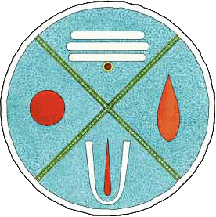 |

|
|
HINDU SECTS
For over 200 years, Western scholars
have struggled to understand Hinduism, a
faith whose followers seemed (to
outsiders) to arbitrarily worship any
one of a dozen Gods as the Supreme, a
religion vastly diverse in its beliefs,
practices and ways of worship.
Some Ideologists labeled the Hinduism they encountered
polytheistic; others even coined new terms, like henotheism,
to describe this baffling array of spiritual traditions.
Few, however, have realized, and fewer still have written,
that India's Sanatana Dharma, or "eternal faith, " known
today as Hinduism and comprising nearly a billion followers,
is a family of religions with four principal denominations Vaishnavism, Saivism, Shaktism, and
Smartism. This single perception is essential for
understanding Hinduism and explaining it accurately to
others.
The four denominations all believe in one God but differ
in their conceptions. |

WORLD RELIGIONS
COMPARED
WORLD
RELIGIONS CLIPART
WORLD
RELIGIONS HOME
HINDUISM HOME |
|
 |
SAIVISM: The primary goal of Saivism is realizing one's
identity with God Siva, in perfect union
and non-differentiation. This is termed nirvikalpa
samadhi, Self Realization, and may be attained in
this life, granting moksha, permanent liberation
from the cycles of birth and death. A secondary goal is
savikalpa samadhi, the realization of
Satchidananda, a unifying experience within super
consciousness in which perfect Truth, knowledge and
bliss are known. The soul's final destiny is
vishvagrasa, total merger in God Siva.
|
|
 |
SHAKTISM: The primary goal of Shaktism is moksha,
defined as complete identification with God Siva.
A secondary goal for the Shaktas is to perform good
works selflessly so that one may go, on death, to the
heaven worlds and thereafter enjoy a good birth on
earth, for heaven, too, is a transitory state. For
Shaktas, God is both the formless Absolute (Siva)
and the manifest Divine (Shakti), worshiped as
Parvati, Durga, Kali, Amman,
Rajarajeshvari, etc. Emphasis is given to the
feminine manifest by which the masculine Un-manifest is
ultimately reached.
|
|
 |
VAISHNAVISM: The primary goal of Vaishnavites is videha
mukti, liberation -- attainable only after death --
when the small self realizes union with God Vishnu's
body as a part of Him, yet maintains its pure individual
personality. Lord Vishnu -- all-pervasive consciousness
-- is the soul of the universe, distinct from the world
and from the jivas, "embodied souls," which constitute
His body. His transcendent Being is a celestial form
residing in the city of Vaikuntha, the home of
all eternal values and perfection, where the soul joins
Him upon mukti, liberation. A secondary goal --
the experience of God's Grace -- can be reached while
yet embodied through taking refuge in Vishnu's unbounded
love. By loving and serving Vishnu and meditating upon
Him and His incarnations, our spiritual hunger grows and
we experience His Grace flooding our whole being.
|
 |
SMARTISM: The ultimate goal of Smartas is moksha, to
realize oneself as Brahman, the Absolute and only
Reality, and become free from samsara, the cycles
of birth and death. For this, one must conquer the state
of avidya, ignorance, which causes the world to
appear as real. All illusion has vanished for the
realized being, jivanmukta, even as he lives out
life in the physical body. At death, his inner and outer
bodies are extinguished. Brahman alone exists. |
Man is a creature of
reflection;
he becomes that upon which he reflects.
Hindu Proverb

| |
 |
 |